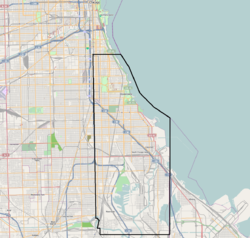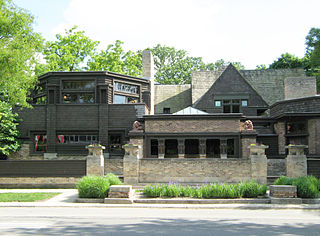
Cook County is the most populous county in the U.S. state of Illinois and the second-most-populous county in the United States, after Los Angeles County, California. More than 40% of all residents of Illinois live within Cook County. As of 2020, the population was 5,275,541. Its county seat is Chicago, the most populous city in Illinois and the third-most-populous city in the United States.

Hull House was a settlement house in Chicago, Illinois, United States that was co-founded in 1889 by Jane Addams and Ellen Gates Starr. Located on the Near West Side of the city, Hull House opened to serve recently arrived European immigrants. By 1911, Hull House had expanded to 13 buildings. In 1912 the Hull House complex was completed with the addition of a summer camp, the Bowen Country Club. With its innovative social, educational, and artistic programs, Hull House became the standard bearer for the movement that had grown nationally, by 1920, to almost 500 settlement houses.

Hyde Park is the 41st of the 77 community areas of Chicago. It is located on the South Side, near the shore of Lake Michigan 7 miles (11 km) south of the Loop.
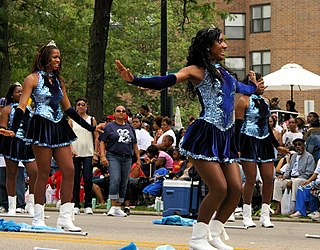
Washington Park is a community area on the South Side of Chicago which includes the 372 acre (1.5 km2) park of the same name, stretching east-west from Cottage Grove Avenue to the Dan Ryan Expressway, and north-south from 51st Street to 63rd. It is home to the DuSable Museum of African American History. The park was the proposed site of the Olympic Stadium and the Olympic Aquatics Center in Chicago's bid to host the 2016 Summer Olympics.

Austin is one of 77 community areas in Chicago Located on the city's West Side, it is the third largest community area by population and the second-largest geographically. Austin's eastern boundary is the Belt Railway located just east of Cicero Avenue. Its northernmost border is the Milwaukee District / West Line. Its southernmost border is at Roosevelt Road from the Belt Railway west to Austin Boulevard. The northernmost portion, north of North Avenue, extends west to Harlem Avenue, abutting Elmwood Park. In addition to Elmwood Park, Austin also borders the suburbs of Cicero and Oak Park.

The Near South Side is a community area of Chicago, Illinois, United States, just south of the downtown central business district, the Loop. The Near South Side's boundaries are as follows: North—Roosevelt Road ; South—26th Street; West—Chicago River between Roosevelt and 18th Street, Clark Street between 18th Street and Cermak Road, Federal between Cermak Road and the Stevenson Expressway just south of 25th Street, and Clark Street again between the Stevenson and 26th Street; and East—Lake Michigan.

Kenwood, one of Chicago's 77 community areas, is on the shore of Lake Michigan on the South Side of the city. Its boundaries are 43rd Street, 51st Street, Cottage Grove Avenue, and the lake. Kenwood was originally part of Hyde Park Township, which was annexed to the city of Chicago in 1889. Kenwood was once one of Chicago's most affluent neighborhoods, and it still has some of the largest single-family homes in the city. It contains two Chicago Landmark districts, Kenwood and North Kenwood. A large part of the southern half of the community area is in the Hyde Park-Kenwood Historic District. In recent years, Kenwood has received national attention as the home of former U.S. President Barack Obama.

Calumet Heights, located on the South Side of the city, is one of the 77 well defined community areas of Chicago, Illinois. Calumet Heights is bounded by 87th Street on the north, South Chicago Avenue on the east, and railroad lines on the west and south.

Hegewisch is one of the 77 community areas of Chicago, Illinois, located on the city's far south side. It is bordered by the neighborhoods of Riverdale and South Deering to the west, the East Side to the north, the village of Burnham to the south and the city of Hammond, Indiana to the east. The community area is named for Adolph Hegewisch, the president of U.S. Rolling Stock Company who hoped to establish "an ideal workingman's community" when he laid out the town along a rail line in 1883, six years before Chicago annexed the town.

Morgan Park, located on the far south side of the city of Chicago, Illinois, United States, is one of the city's 77 official community areas. Morgan Park is located south of the Beverly neighborhood and north of the Chicago city border, and includes Mount Greenwood Cemetery. The community, settled in the mid-19th century, was initially known as North Blue Island, being located close to the existing town of Blue Island to the south. As of 2013, Morgan Park was majority-black, with approximately 22,924 residents in 2015.

Illinois's 2nd congressional district is a congressional district in the U.S. state of Illinois. Based in the south suburbs of Chicago, the district includes southern Cook county, eastern Will county, and Kankakee county, as well as the city of Chicago's far southeast side.

Paul Cornell was an American lawyer and Chicago real estate speculator who founded the Hyde Park Township that included most of what are now known as the south and far southeast sides of Chicago in Cook County, Illinois, United States. He turned the south side Lake Michigan lakefront area, especially the Hyde Park community area and neighboring Kenwood and Woodlawn neighborhoods, into a resort community that had its heyday from the 1850s through the early 20th century. He was also an urban planner who paved the way for and preserved many of the parks that are now in the Chicago Park District. Additionally, he was a successful entrepreneur with interests in manufacturing, cemeteries, and hotels.

Washington Park is a 372-acre (1.5 km2) park between Cottage Grove Avenue and Martin Luther King Drive, located at 5531 S. Martin Luther King Dr. in the Washington Park community area on the South Side of Chicago. It was named for President George Washington in 1880. Washington Park is the largest of four Chicago Park District parks named after persons surnamed Washington. Located in the park is the DuSable Museum of African American History. This park was the proposed site of the Olympic Stadium and the Olympic swimming venue for Chicago's bid to host the 2016 Summer Olympics. Washington Park was added to the National Register of Historic Places on August 20, 2004.

Washington Square, also known as Washington Square Park, is a park in Chicago, Illinois. A registered historic landmark that is better known by its nickname Bughouse Square, it was the most celebrated open air free-speech center in the country as well as a popular Chicago tourist attraction. It is located across Walton Street from Newberry Library at 901 N. Clark Street in the Near North Side community area of Chicago, Illinois, USA. It is Chicago's oldest existing small park. It is one of four Chicago Park District parks named after persons surnamed Washington. It was added to the National Register of Historic Places on May 20, 1991.
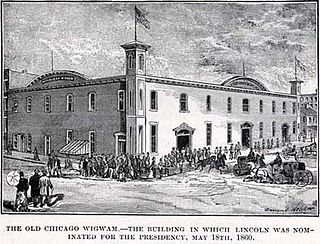
The Wigwam was a convention center and meeting hall that served as the site of the 1860 Republican National Convention. It was located in Chicago, Illinois, at Lake Street and Market near the Chicago River. This site had previously been the site of the Sauganash Hotel, Chicago's first hotel. This is where supporters ushered Abraham Lincoln to the party nomination and the eventual U.S. Presidency. The location at Lake and Wacker was designated a Chicago Landmark on November 6, 2002. The name "Wigwam", although separate structures, was later associated with host locations for both the 1864 Democratic National Convention and the 1892 Democratic National Convention in Chicago.
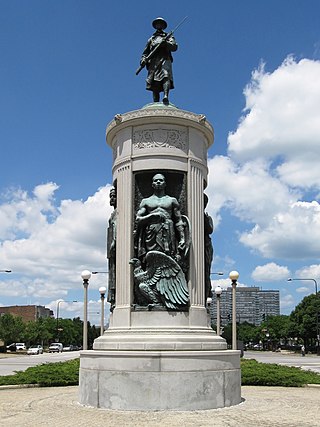
The South Side is an area of Chicago, Illinois, U.S. It lies south of the city's Loop area in the downtown. Geographically, it is the largest of the three sides of the city that radiate from downtown, with the other two being the north and west sides.

Pill Hill is a neighborhood in the Calumet Heights community area on the South Side of Chicago, Illinois, United States.
Jefferson Township is a former civil township in Cook County, Illinois, United States that existed as a separate municipality from 1850 until 1889 when it was annexed into the city of Chicago. Its borders were Devon Avenue on the north, Harlem Avenue on the west, Western Avenue to the east, and North Avenue to the south. This region comprised most of what is now known as the Chicago's Northwest Side including the entirety of the following community areas: Jefferson Park, North Park, Albany Park, Irving Park, Avondale, Hermosa, Belmont-Cragin, Montclare, Portage Park, as well as parts of Forest Glen, West Ridge, Lincoln Square, North Center, Logan Square, West Town, Humboldt Park, Austin, Dunning, the suburb of Norridge, the suburb of Harwood Heights, and Norwood Park.
